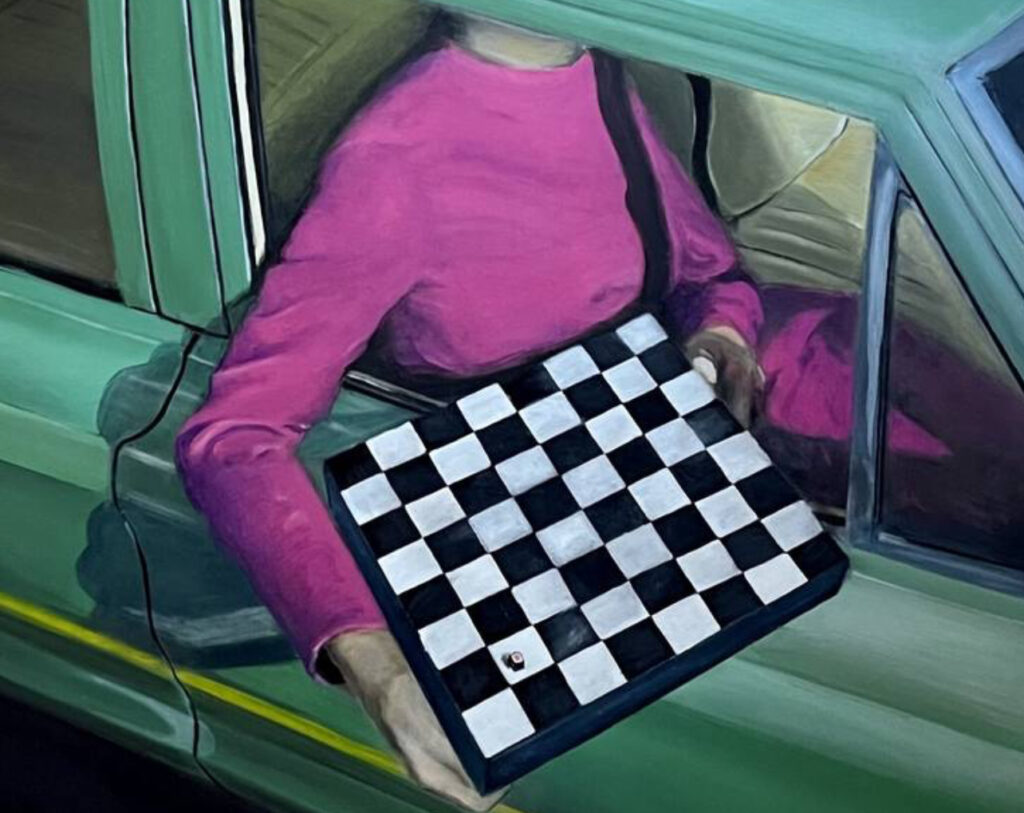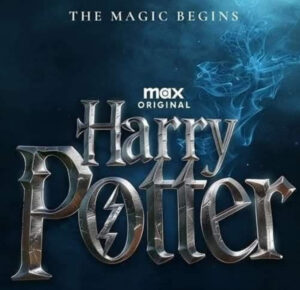In Sushi Delivery, Ukrainian painter Anna Kryvych offers a scene as sharply cropped as it is psychologically charged. We see a green car. A woman in a saturated pink top. Her head, cropped from the frame. Her arm extends through the window, holding a black-and-white checkered board toward the viewer like an offering—or perhaps a quiet challenge.
There is no sushi in the image. No delivery bag, no packaging, no food. The title feels deliberately misleading—or at least dislocated. And that dislocation is the key to the work’s power.
This is not about sushi. It’s not about games either. It’s about ambiguous exchange, and the moment of reaching outward from an enclosed, uncertain space. Kryvych renders that gesture—arm out, board in hand—as a metaphor for modern existence: transactional, curated, a little performative, and deeply human.
At First Glance: Composition and Cropping
The viewer is denied a full portrait. The subject’s head and face are absent, replaced by the bright presence of her clothing and the angular framing of the car window. This intentional omission distances us from the person, yet draws us closer to the act—the extended hand, the board, the visual pause.
The cropping is cinematic. It echoes film stills from 1970s European cinema, where characters are often positioned just outside the frame of comprehension. Kryvych invites you to build your own narrative but gives you only the edges to start from.
Her use of geometry enhances this tension. The board itself—a crisp checkered grid—introduces rigidity and order into a scene that otherwise feels fluid. The car, with its soft curves and green gradients, contrasts sharply with the hard-edged logic of the board. The scene is domestic and surreal, inert and alive.
Color, Texture, and Emotional Tone
Kryvych’s color work is restrained but exact. The minty green of the car body speaks of a specific era—mid-century or retro-futurist, maybe a Soviet-era sedan. It’s utilitarian but nostalgic. The pink top is electric, almost jarring, cutting sharply through the greens like an act of resistance.
The texture of the paint is smooth, but not overly polished. Brushstrokes are controlled, yet present. The car’s body gleams slightly, while the fabric of the pink sleeve carries gentle folds and subtle variations—enough to remind you that this is not a photo. It is an act of intentional seeing.
There’s a single object placed on the board—a red-and-white die, or a game piece of some sort. It introduces a point of tension. A decision waiting to be made. Or maybe one that already has been.
Title as Misdirection
Why Sushi Delivery?
There are no food elements. No delivery bag. No signifiers of the meal the title implies. And yet, the phrase echoes in your mind as you examine the image. That’s the point.
Kryvych uses the title to reframe your expectations—to create a semantic dissonance between what is named and what is seen. It’s a trick. A layer. A commentary.
Perhaps the woman in the car is delivering something else entirely—a message, a question, a set of choices. Maybe the board itself is the delivery. Or maybe the term sushi—so associated with clean presentation, urban modernity, global culture—is meant to contrast with the stillness, intimacy, and analog textures of the painting.
The delivery is not food. It’s metaphor. It’s discomfort. It’s the act of holding something out and not explaining it.
The Car as a Psychological Space
The car, in contemporary art and literature, is often a metaphor for containment, isolation, or transit. Kryvych uses it as all three.
Here, the car is both private and public—her window open, her body half-in, half-out. She occupies a liminal space. It’s not a setting, it’s a container. A cocoon. And when she reaches outward, it doesn’t feel like freedom. It feels like risk.
She’s not getting out of the car. She’s not stepping fully into the world. She’s staying inside—and yet she extends something to us. This tension—between exposure and withdrawal—is central to the emotional force of the painting.
No Face, No Voice, Only Gesture
There is no face to study. No eyes to meet. And yet, the image is not impersonal. It is intimate in its limitation. The only communication we receive is the gesture: the hand, the arm, the board.
Kryvych transforms that gesture into a kind of mute language—a signal sent across space without words. It recalls a move in chess, or the passing of a note through a car window.
By removing the face, the artist removes identity and replaces it with possibility. The woman could be anyone. Her action becomes the focus. And that shift makes the viewer complicit. You’re not watching her. You’re receiving what she offers—or deciding whether to take it.
A Scene of Suspension
There’s no visible motion. The car is parked. The woman is still. The board is held perfectly horizontal. Everything is paused.
This is what makes the painting so arresting. It exists in a state of incomplete exchange. A gesture offered but not yet answered. A move made, but not responded to.
Kryvych captures that in-between space—what poet Ocean Vuong called “the half-second before a door opens, when the moment is both full and empty.” The woman does not speak. She does not leave. She simply holds out the object. And the moment suspends, forever.
Cultural and Temporal Context
Anna Kryvych’s work exists in the wider context of contemporary Ukrainian art—a scene shaped in recent years by displacement, uncertainty, and redefinition.
While Sushi Delivery does not overtly address the war in Ukraine or current events, it carries within it the aesthetics of distance: the feeling of offering something fragile while still seated in a place of guardedness. The reach of the hand, the separation of the subject, the idea of mobility without motion—all echo the collective unease of a country that has had to recalibrate every version of “normal.”
Whether intentional or not, the painting speaks to a time when connection feels precious—and strange.
Interpreting the Board
Let’s return to the board, square and stark, its checkered pattern visually dominating the center of the composition.
It might be a chessboard, a checkerboard, a metaphorical game space. The single visible piece—tiny, unclear—evokes the start of play or its solitary end. There’s no opponent. No clear rules. Just the grid, and the act of holding it forward.
The board becomes a symbol of structure, of logic, of choice. Kryvych places it at the painting’s heart, and in doing so, suggests that the most ordinary object can hold enormous psychic weight.
This is not just a game. It’s an offering. It’s a question.
An Image That Holds and Waits
Anna Kryvych’s Sushi Delivery is a painting of stillness, of gesture, of meanings that resist resolution. It’s an image about a moment stretched thin—a visual haiku of posture and pause.
There is no clear story here. There is no punchline. And that’s the brilliance of it.
In an era addicted to fast meaning, Kryvych gives us a slow one. She asks us not to understand, but to observe. Not to define, but to receive.
No comments yet.








